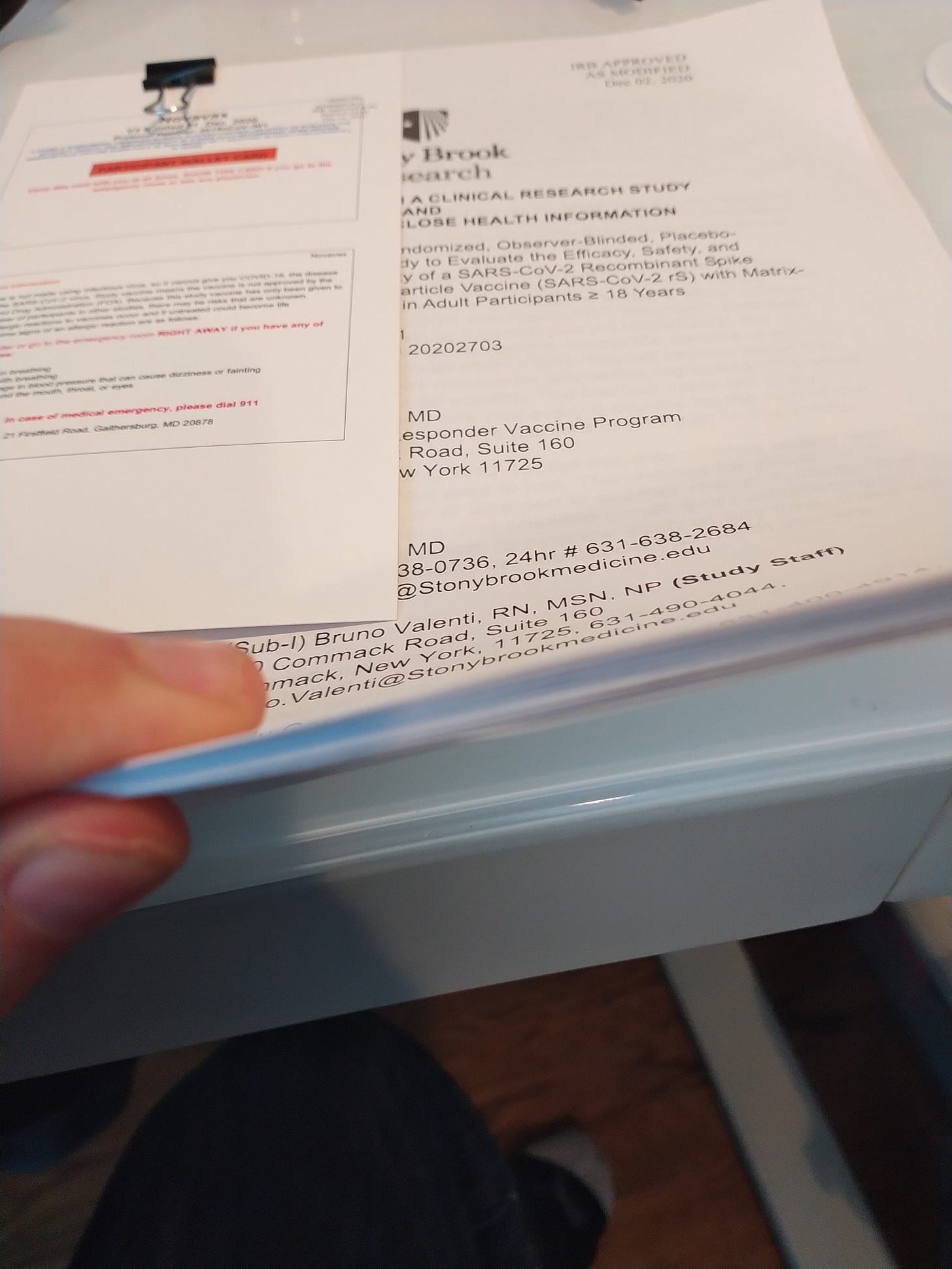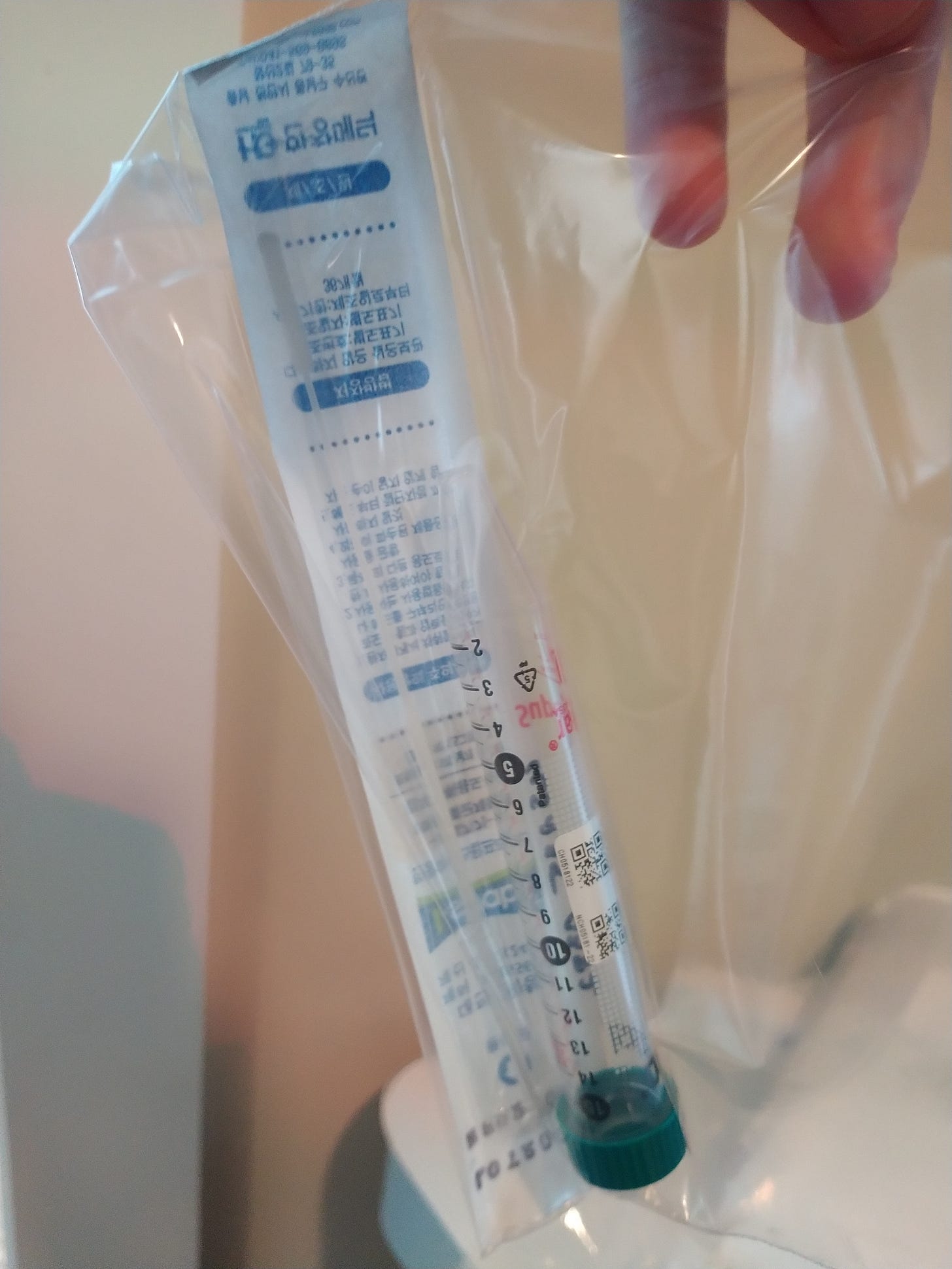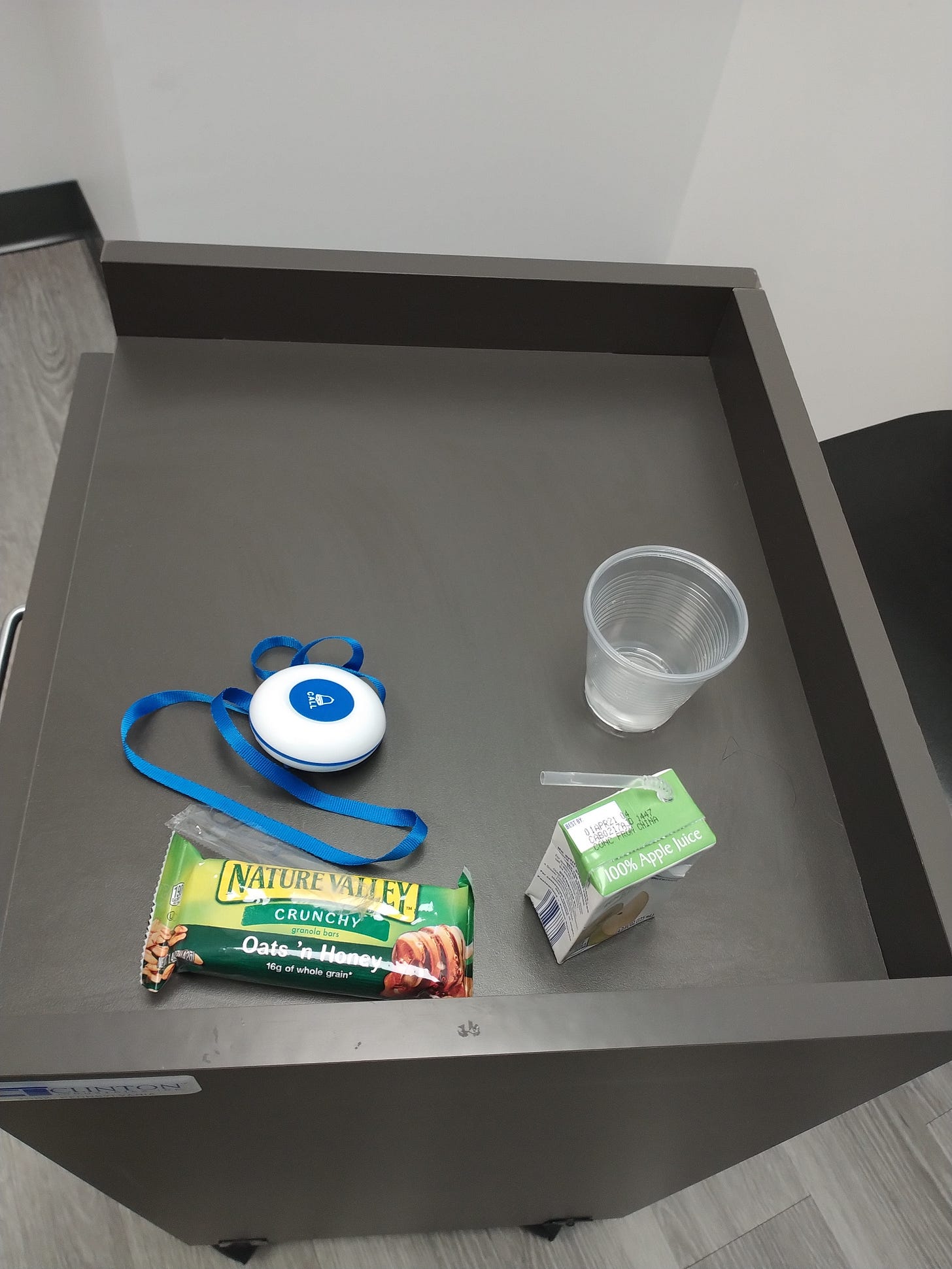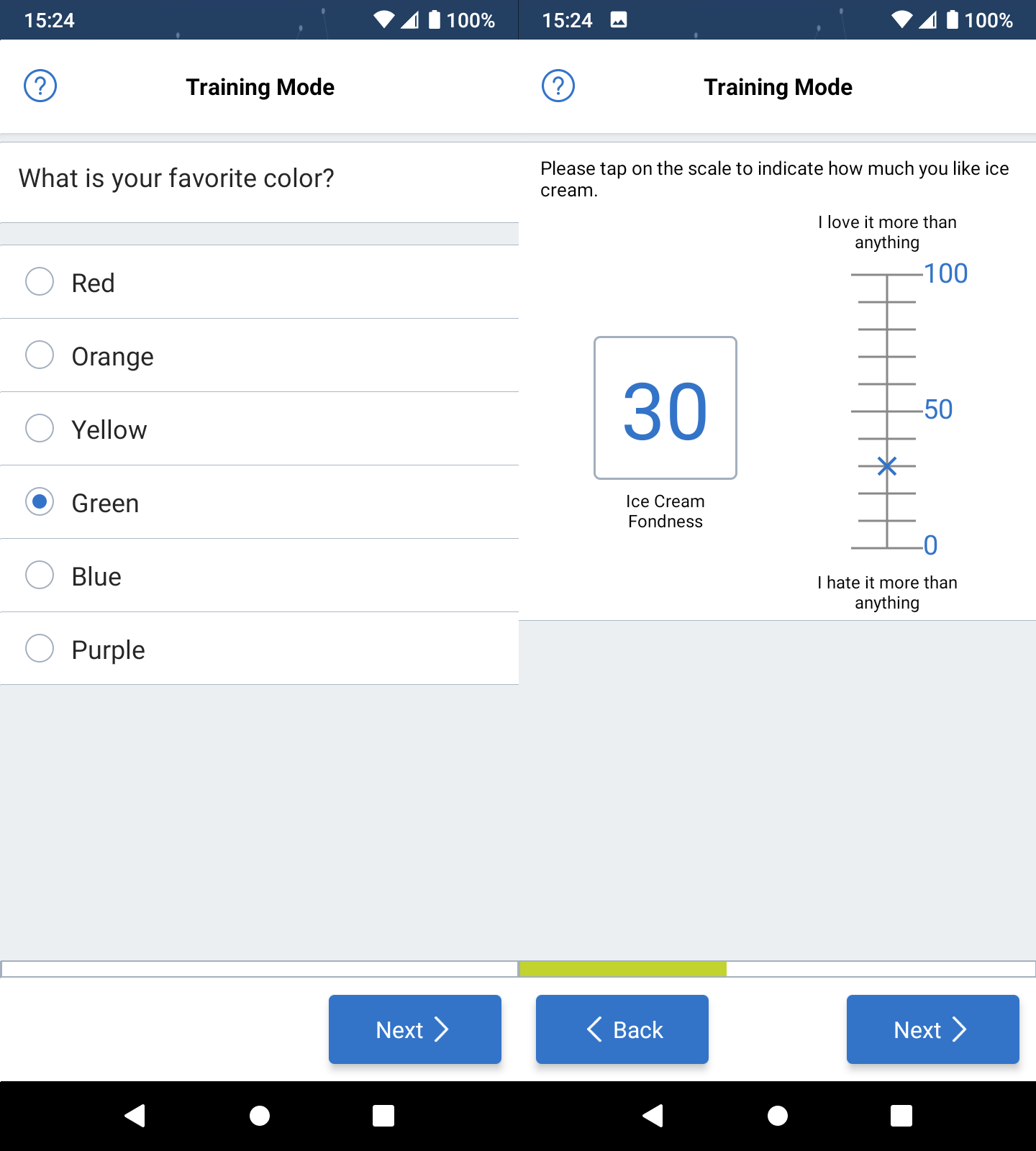Participating in a Covid-19 Vaccine Trial
post by ejacob · 2021-02-11T20:35:37.740Z · LW · GW · 14 commentsThis is a link post for https://eidan.substack.com/p/the-vaccine-trial-chronicles-1
Contents
Day -2: Registration Day -1: Orientation Day 0: First Visit and Vaccination None 14 comments
I live near Stony Brook University, which has a well-known hospital and medical school. About a month ago I signed up to participate in research related to Covid-19. As a work-from-homer, this was a way I could reasonably get a vaccine without resorting to “skipping the line” or pretending I had a pre-existing condition. Today I received my first dose. Here is the story to date. I plan to post at least one follow-up to this.
The study I'm participating in is a phase III trial for the Novavax vaccine. Studies in the UK and South Africa already have demonstrated it to be safe and effective (at least to a similar standard as the Pfizer and Moderna options). Novavax also has the added advantage that it can be kept stable at higher temperatures than the mRNA vaccines. I'm not opposed in principle to studying its efficacy more, but I think it's silly that this trial has to happen before it can be distributed or used in the US. FDA Delenda Est.
Day -2: Registration
I receive a phone call from a lady calling herself Bella. Bella asks if I am still interested in participating in Covid-19 vaccine trials. I am. She takes my name, address, medical history, etc. She says to expect an email with directions to the clinic and some videos to watch.
Day -1: Orientation
In the morning there is an email from Bella with links to a required series of introductory videos. After each video there are a few questions to make sure I was paying attention. The videos are old. I can tell they are old because the second one says “There is no approved vaccine available for Covid-19.” Unforced error count: 1. One of the questions for this video asks if there are any approved vaccines available for Covid-19. I know what will happen if I get a question “wrong,” and I don’t want to try asking anyone to update the form, so I select “no.” I’ve already entered a simulacrum. I learn that if I participate in the study, I will receive the Novavax Covid-19 vaccine with probability 2/3 or a placebo with probability 1/3, and earn up to $1700 depending on how diligently I participate in follow-up. Sounds great.
Day 0: First Visit and Vaccination
I get in the car and drive to Stony Brook University Medical Center’s satellite clinic in Commack, NY. I walk in to a large lobby. A sign on the information desk says “COVID-19 STUDY: ROOM 201.” I go to suite 201 and enter another lobby. I walk up to the receptionist.
Am I here for a nasal swab? No, I’m here for the vaccine trial. What is my name? I say my name. I’m not on the list. She hands me the list of names. I should not be allowed to see the list of participants, I’m just some random dude! Unforced error count: 2. I confirm I’m not on the list. She hands me a post-it to write my name down. I write it and take a seat.
While I’m waiting my phone rings. A voice introduces herself as Kathryn and asks if I’ve found the trial. Yes I have, I’m in the waiting room right now, I just gave the woman my name. Which room am I in? 201. That’s the wrong room; that one is doing a different trial. I should wait and she’ll come get me; it should only be a minute.
I get up and explain to the receptionist that I was in the wrong room and she can forget about me. She discards the post-it. No reason to sit in the same room with other people when there’s an empty hallway nearby. Social distancing, right? I wait outside room 201. A woman in scrubs walks up. Are you Kathryn? Uh, no. Oops, sorry. Another woman in scrubs approaches. Are you Kathryn, here to bring me to the vaccine trial? No, I’m just getting my steps in. I grow uncomfortable accosting innocent female healthcare workers and reenter suite 201. I sit back down to wait. Another minute passes and Kathryn arrives. She is not wearing scrubs.
Kathryn leads me down a stairway and makes some small talk. I mention that I’m interviewing later today with a startup involved in prediction markets. “Interesting!” I infer she either misunderstands what I meant by prediction markets or is politely pretending to know what they are. We reach the correct suite and go into a room. It is barren aside from two chairs, a desk, and a computer. Can I please confirm my name and birthday? I do. Do I consent to participate in the study? I do. Do I wish for the researchers to share information with my primary care doctor? That sounds complicated. No thanks. Do I consent to having leftover blood samples used for other research? Sure. Am I aware that they might not take blood samples even though they’ve asked that question? I suppose I am. Am I aware that I can answer no to either of the past two questions and still participate in the vaccine study? Yes.
The entire time we’re in the room the door is closed. I presume this is required to protect my privacy, but I notice that the reduced ventilation increases the chance of SARS-CoV-2 transmission. I’m wearing an n95 under a surgical mask and Kathryn is wearing a face shield over a surgical mask, so I decide it’s not worth raising the issue. I conclude opening the door wouldn’t meaningfully affect my privacy but only slightly reduce infection risk. Still, unforced error count: 3.
After scheduling my next appointment, Kathryn gets up and exits, returning a few moments later with an iPad. I sign a form on the screen. On the next page I sign again. Kathryn takes the iPad and passes me a clipboard with more consent forms and an emergency contact information form. As I’m filling those out Kathryn asks how involved I am in trading stocks. Huh? Oh, right, I talked about prediction markets. The conversation takes a brief detour through the recent GameStop and AMC short squeezes. I give a basic explanation of prediction markets, and say I am interested in how prediction markets can affect the future. I propose that if prediction markets were a normal thing, then (for example) perhaps back in January of last year, when the WHO was still really hesitant to sound the alarm on Covid-19, a bunch of private citizens/experts could have made bets that large numbers of Coronavirus cases would arise. Then, maybe people and governments could have reacted somewhat faster, inferring from the bets that despite the WHO’s assurances a pandemic was likely. Kathryn's eyes go wide. Wait, did I just rationality-pill this lady? I hand her the completed forms.
Kathryn leads me through a hallway to another room with your standard doctor’s office furniture. I sit on the exam chair. Kathryn leaves and is replaced by a young nurse. Her name is Rose and she takes my medical history. (Of course, she closes the door first). Can I confirm my name and birthday? I do. What prescriptions am I on? I tell her. Do I take any vitamins? D and B12. Herbal supplements? None. Do I have cancer? No. Have I done any drugs? “No, I’m a very good boy,” I answer. Rose giggles; we have a rapport. Have I been in contact with any confirmed cases of Covid-19 in the past 10 weeks? No.
Then some demographic questions. Am I hispanic or latino? No. (It occurs to me later I accidentally answered that question in Spanish, which may have been confusing). What is my race? I’m a bit complicated. I prefer to write “Jewish” if the question allows, but I basically look White.
Halfway through Rose is joined by an older nurse. She doesn’t introduce herself and starts prepping a blood draw kit. Rose takes my blood pressure and pulse. Older Nurse turns to me and asks me to confirm my name and birthday, which I do. She begins to repeat other questions that Rose has already asked, but Rose interrupts and tells her she has already covered it. Thank god. Rose removes the blood pressure cuff and Older Nurse wraps a tourniquet around the freed arm. She fills a few vials while Rose is typing away at a computer.
I know from experience I don’t react well (purely psychosomatically, probably) to blood draws, but I also know this volume is smaller than a normal blood test so I don’t expect to react too strongly. I am wrong. Once the needle is removed, I have my usual minute or two of dizziness, nausea, and sweating, which promptly causes Rose to overreact. I’m handed multiple cups of water, a juice box, and a granola bar. By the time they come back to check on me I am completely recovered.
I’m pretty hairy, so for small wounds (like needle holes) I prefer not to use tape or sticky bandages. Older Nurse doesn’t let me refuse for some reason. I’ve never had this happen before. I wonder if I’ve offended her for some reason that she wants to cause me such a petty amount of pain.
Rose leaves. Older Nurse gives me a Covid-19 nasal swab, collects her blood samples, and follows. She returns a few minutes later and hands me a thick stack of copied consent forms.

She also has a bag of three testing kits, a clear ruler, and a thermometer. The ruler is for measuring any redness around the injection site. She demonstrates to me how to use a ruler. “Each of these lines is .1, or 1/16 of an inch. So if you were to measure something as 1 and 11/16ths, you should write 1.11.” This system of mathematics is beyond my understanding. Unforced error count: 4. She explains how I would swab myself and take my temperature. If I have symptoms, I may be asked to swab once a day for three days after I report them. Older Nurse asks if I understand. I do. Have I received the vaccine shot yet? No, they must be saving the fun part, I answer. She doesn’t laugh. Why doesn’t Older Nurse like me? Rose liked me. I miss Rose.

Older Nurse leaves and I’m alone for a minute or two. Then a man walks in. He is a nurse practitioner and is going to give me a brief physical exam. Can I confirm my name and birthday?
Nurse Practitioner asks me some medical history questions that are largely redundant with the ones Rose asked. I consider mentioning this, but I realize that Rose must have been taking my medical history for the hospital, but Nurse Practitioner is taking my medical history for the experiment, and of course I shouldn’t expect them to talk to each other. More of an unforced inconvenience than an unforced error, I guess. New questions include: Do I have any allergies to phosphate-enhanced saline? Do I have any allergies to saponin, a.k.a. Soap Bark? He also asks about who I live with and their occupations. I deduce he is trying to get an idea of my risk of coronavirus exposure. NP asks me to stand up and touch my toes, checks my ears and throat, and does the normal physical exam ritual. Then he asks me to smile, frown, puff out my cheeks, and raise my eyebrows. I think he’s joking at first, but then realize he’s confirming I do not have Bell’s palsy. NP is satisfied I’m in good health and leaves.
A new nurse comes in. Her name is Mary. Can I please confirm my name and birthday? I confirm for what feels like the twentieth time. Mary gives me a mystery shot, which was the Novavax vaccine with probability 2/3. Mary tells me that I have to wait at least half an hour before leaving in case of any adverse reaction and hands me a nurse call button. Press here if too lonely. I crack myself up. Mary leaves.

Another woman walks in and instructs me in downloading and using a health diary app, PatientCloud. It is all very straightforward and we fly through the tutorial. She also hands me a check for $170. Cool. I’m all done!

I have about fifteen minutes before my half-hour observation period is up. I want to leave early but I’m concerned it might jeopardize my study participation or otherwise get someone in trouble. I wait, and then step outside. I remove my mask and take in the cool air on the way to my car. A flute concerto plays on NPR as I turn on Suffolk County Route 4 and head home.
My next appointment is in March. I will receive my second dose then.
14 comments
Comments sorted by top scores.
comment by Daniel Kokotajlo (daniel-kokotajlo) · 2021-02-12T11:30:10.216Z · LW(p) · GW(p)
Are you sure it's a good idea to use these people's real names? It's a pretty low-stakes story etc. but it seems like good practice in general to anonymize I think.
Replies from: ejacob↑ comment by ejacob · 2021-02-12T17:19:42.261Z · LW(p) · GW(p)
You may be right, I could have thought about that more carefully. For what it's worth, everyone I named was professional and courteous so I wouldn't want any negative consequences for them. It's also not too hard to figure out my real name so the playing field is even at least.
Replies from: daniel-kokotajlo↑ comment by Daniel Kokotajlo (daniel-kokotajlo) · 2021-02-12T19:30:49.388Z · LW(p) · GW(p)
It's not too late to make up some fake names and go do a substitution!
I agree it's extremely unlikely anything bad will come of this, it just seems like a good habit to get into.
Replies from: ejacobcomment by Maxwell Peterson (maxwell-peterson) · 2021-02-12T18:18:27.002Z · LW(p) · GW(p)
Nice story! All the little details made it fun to read.
comment by ChristianKl · 2021-02-12T00:04:10.597Z · LW(p) · GW(p)
Did you promise not to take other vaccines? Do you know that you got a vaccine and not a placebo?
Replies from: ejacob↑ comment by ejacob · 2021-02-12T00:33:07.589Z · LW(p) · GW(p)
I am allowed to take any other vaccine if it is available and still participate in the study. (Given my youth and lack of risk factors it might actually take about as long as the study lasts before I'm eligible so this is mostly academic).
It's double blind so I won't know until the end.
comment by CraigMichael · 2021-02-12T10:50:49.289Z · LW(p) · GW(p)
What color was the liquid in the vaccine? B12 is often used for placebos and had a characteristic color.
Replies from: ejacob↑ comment by ejacob · 2021-02-12T17:10:35.272Z · LW(p) · GW(p)
Looked like water. I think the only way to get a good idea is to have an antibody test in a few weeks.
Replies from: cistran↑ comment by cistran · 2021-02-12T20:44:40.726Z · LW(p) · GW(p)
Does accessing antibody test results break the double blind? Are you sure you didn't consent to not doing that?
Replies from: ejacob↑ comment by ejacob · 2021-02-13T01:29:50.854Z · LW(p) · GW(p)
Short answer is yes, it mostly does, but they'll test me anyway. I didn't have to agree to anything that could possibly prevent me from receiving the best healthcare I would otherwise get. I'm pretty sure/hope such a condition would not have been allowed by any IRB.
I spoke with a pathologist in my family and together we estimated that a positive blood antibody test ~2 weeks after the 2nd vaccine dose would have a likelihood ratio on the order of 50:1 or more in favor of having had a response to the vaccine. (This is specific to me - my lifestyle protects me very well from possible infection (I have close contact with very few people, most of whom have received a vaccine themselves or have recovered from covid a couple of months ago); I would reduce this estimate for an average person). So if we find antibodies in my blood about a month from now I would be quite comfortable concluding I received the vaccine (recall the prior odds are 2:1 in favor, updating based on the test makes it 100:1; a near certainty). Likewise a negative blood antibody test would strongly I did not receive the vaccine.
Replies from: cistran